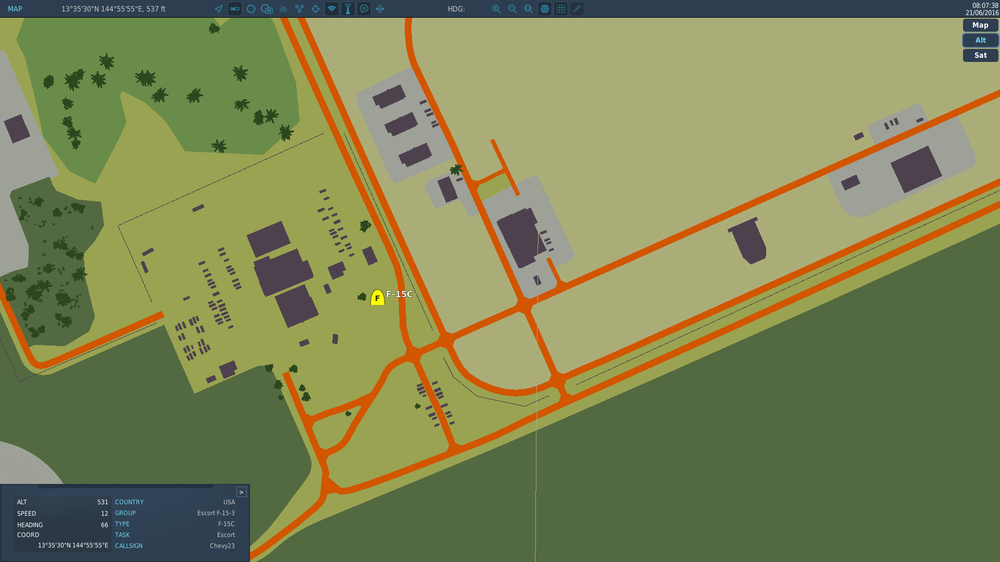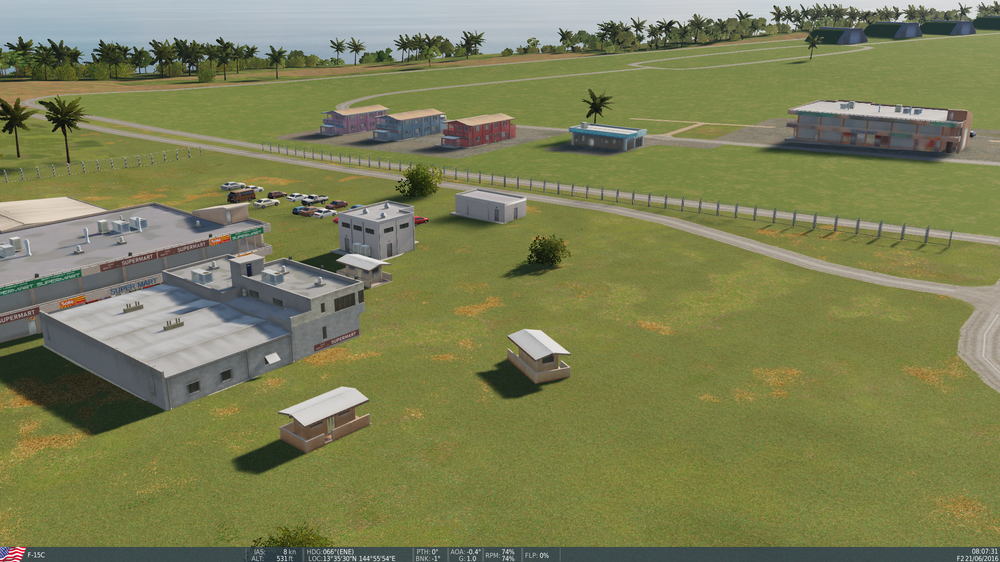-
Posts
78 -
Joined
-
Last visited
Recent Profile Visitors
The recent visitors block is disabled and is not being shown to other users.
-
BLUF: With the addition of more modern modules, I believe the flare implementation in DCS should be expanded to represent both threats and counter-measures better. This could be done rather simply by adding another flare type and changing how IR missiles react based on which of the flares is being presented to them. Changes would be needed to how flare programming is done, both in how they are loaded on the bird and how they are dispensed on activation. The Nerdy Stuff The current flare implementation appears to represent pyrotechnic flares, similar to the US's M206 flare. These flares were developed after the introduction of the first IR missiles. These early missiles were optimized to track hot metal components of aircraft, like engines and tailpipes. Correspondingly, these flares burn at temperatures mimicking those components, but with much higher intensity. This would cause the missiles to track the flares over the aircraft, as they are set up to track the highest intensity target. These are the flares that everyone associates with "flares". They are a giant ball of light with a thick white smoke plume behind them. To counter these pyrotechnic flares, IR missile designers started to design their missiles with counter-countermeasures. There are multiple ways to do this, but I'm going to focus on the Russian implementation, as most modern modules are US aircraft. Starting with the Igla (SA-18), the Russians began to incorporate more than one detector in the seeker, with each seeker operating in a different band of the IR spectrum. This was done to both improve tracking capability and counter IR flares. I won't go into too much detail as the intricacies can't be modeled in DCS anyway. To summarize, the system uses the two detectors to compare the IR signal of the aircraft and a potential decoy to determine which is the aircraft. Since the only flare at the time was the hot pyrotechnic flare, that's what the systems were designed to defeat. To counter this technique, multiple methods were developed to defeat it. One was the development of new flares, called pyrophoric flares. These flares burn differently from the pyrotechnic flares and give off a different IR signature, notably in the IR band of the engine plume that these newer missiles use to track aircraft. They also have a distinctly different visual signature, looking more like a glitter bomb in an IR camera and almost no visual signature. It also has a different trajectory. One example of these is the M211 flare of the US. The Proposal I would like to see these pyrophoric flares incorporated into DCS. The current implementation of a simple percent chance to decoy on a flare can be kept, with a simple modification. Each missile will now have two percent chance values, based on the flare type being presented. An older generation missile will have a high chance of decoying on the pyrotechnic flares designed to defeat them, with a lower decoy chance on the pyrophoric flares that don't burn as intensely. The inverse would be valid for the more advanced missiles that have different flares tailored to defeat them. You could expand this even further to other flare types, such as kinematic flares or even IR jammers. This doesn't require an in-depth rework of the IR missiles, but significantly improves the authenticity of the threat environment and adds another gameplay element for players. Pilots will need to consider the type of threat in the area (older IR vs newer IR) and decide how to counter those threats best. It's no longer just spamming flares because they are all the same, and all missiles react the same. Consideration will need to be given to what flares are being brought, how many of each type, and what pattern will be deployed with each dispense. The Hard Part There would need to be some interface to allow pilots to load up customized configurations of flares. The data cartridge makes this easier, and perhaps the multi-rocket type implementation in the Apache can be leveraged as a framework. At the very least, pilots need to be able to select the number of each flare type to be loaded. A full implementation would allow pilots to change the loadout per flare dispenser. In the same way, pilots would need more control over how the flares are dispensed from the aircraft. I'm not sure if the current onboard systems of any aircraft are capable of this without a data cartridge implementation. Was that a lot? Yep. Check my post history if you enjoyed for more. I'm not gonna plead, the developer will do what they think they can in the areas they believe need improvement. Hopefully, they will decide this is one of those areas. Some sources: SA-18 Overview Thesis Discussing IR Missile Design JPEO Flare Overview Flare Discussion
-
- 3
-

-
Ah, that would be the answer! Thanks for the clarification.
-
RocketmanAL changed their profile photo
-
I checked multiple different aircraft as part of testing I'm doing. Same altitude, same speed, same mission. The SU-25T was the only one to have a different TAS at M= .8.
-
The Mach number portion of the speedometer appears to be off. It is showing a higher Mach number than the aircraft is actually flying according to TAS. Steps to replicate: Add SU-25T and set it to start at M= .8, 20kft, TAS should be 496 kts. Jumping in the plane it shows the plane at M= .92. Indicated M=.8 occurs around 432 kts.
-

Stand-off Weapon Ranges and Time of Flight Guide
RocketmanAL replied to RocketmanAL's topic in General Tutorials
I've updated this report to V2.0, adding AGM-88C, Kh-58U, and Kh-25MPU information. Guide Download Also produced a YouTube video going over the guide and a couple of applications YouTube Overview -
Ok, just so I understand. The problem is that the missile is acquiring the sun through the clouds. This was a complete overcast weather scenario. Is this a problem with the WIP clouds? I know the air-to-air missile still has the ability to lock on and track through clouds. Also doesn't explain the behavior I was seeing where the missiles were showing similar wild misses when facing the opposite direction of the sun. I know you weren't able to replicate it, but I can provide a video showing as such. Side note: Will the SA-13 ever get its photo contrast mode?
-
Noticed since this most recent patch that the SA-13 is having problems with targets that are near head-on/tail-on aspect. Previously it had problems with tail-on. The system seems to track behind the aircraft as it approaches/departs from the system. Not close enough that I think it's tracking the aircraft, nor the plume from the engine, and it just loses track during launch. It's far enough away that the AI should know there's nothing in the seeker FOV, yet they continue to fire. There isn't anything in the area for the missile to acquire either, completely overcast, and it makes no attempt to maneuver toward the aircraft. Prior to this patch, the system had no problem acquiring and engaging from the head-on aspect but now appears to have lots of problems. The missile also appears to be fuzing early, while the motor is still burning. It just self-destructs around the altitude of the aircraft or slightly above despite being far enough away that it should not fuze. When passing the system on a beam aspect it, and the missile, appear to have no problems. Attached track file with a relevant example from 5:30-6:00. SEAD Strike.trk
-
SA-17 Search Callout As the title says, the SNOW DRIFT appears to be listed under the SA-11 and SA-17 in the Apache RWR database. Seems to indicate we may be getting an SA-17 at some point, which would be a significant improvement over the SA-11. SA-17 Details
- 9 replies
-
- 1
-

-
- apache
- combined arms
-
(and 1 more)
Tagged with:
-
Was testing out a mission and had an interesting bug. Instead turning to taxi it continued to taxi across the ramp and through the grass in a straight line. It was going by buildings and stuff. There was also a graphical bug where if you zoom in the aircraft is non-visible. If you zoom out it becomes visible again. I'm attaching the trk file but it shows it taxing properly when I reviewed it. When I re-ran the mission the same aircraft taxi'd properly, so not very repeatable. Quam F-15.trk
-
I'd like to try and do a mission with multiple player JF-17's in a flight. However, I haven't been able to figure out if you can actually assign different PP points to each aircraft in the flight and they all appear to get the same four that I've put in. Is this possible? Couple of work arounds I know of are making each aircraft it's own flight and/or using the F10 map and having each person put in their own PP points to ingestion into the DTC. However, doing it in the ME for the same flight would be ideal.
-
Have a MP mission that appears to be crashing due to the AI MI-24P for some reason. The MI-24Ps are uncontrolled on the ramp. Loading in SP the mission runs fine, but when running it on a dedicated server causes client crashes when joining the server. After a lot of isolating removing the Hinds appears to fix the problem. Sending a link to a folder with one mission with the Hinds, and one where the only change is taking them out. Including .trk file. Don't have log file but can redo the error if requested. Mission files and track file
-
Put this guide together for mission planning purposes. Provides employment range and time of flight for the various stand-off weapons in DCS at different altitudes. Ranges represent max employment range as calculated by the aircraft at the speed and altitudes listed. TOF was measured in-game, but only used single runs. So some variance can be expected. Also the SLAM-ER appears to be a bit bugged right now, and when using the HIGH flight profile will cause the missile to fly low instead. Guide reflects current behavior in game. DCS Standoff Weapons Ranges_V1.0.pdf
-
Version 1.2 now available. Changelog: Added SA-5 Modified the Patriot to reflect new radar behavior Moved quick reference cards to front of packet
-
I've updated the guide to V1.1. Added the NASAMS, corrected a few deployment layouts, and retested some capabilities against PGMs and updated relevant systems.




